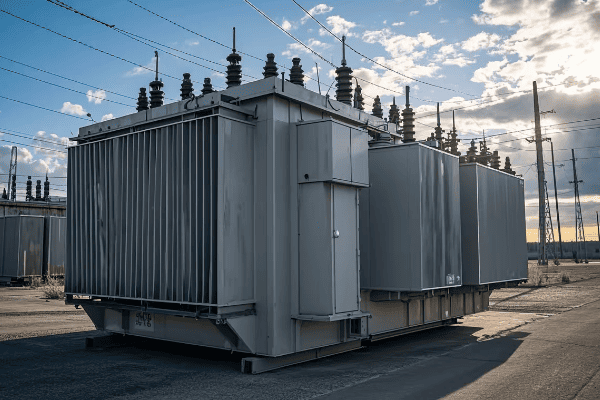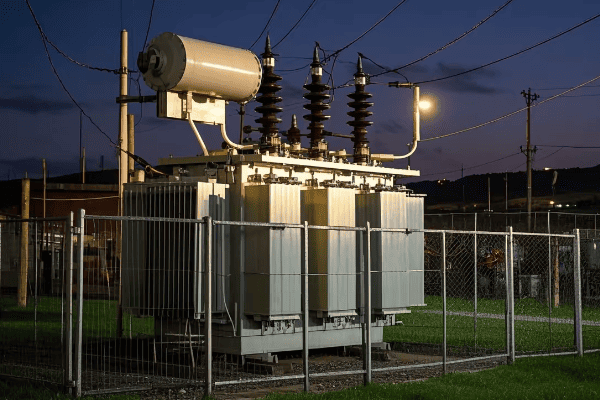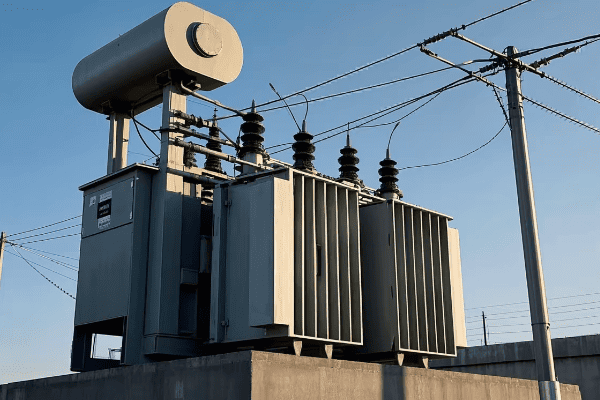What Is a Power Transformer: A Comprehensive Guide for Beginners?
Have you ever wondered how electricity safely powers your home? The answer lies in a crucial device that often goes unnoticed: the power transformer.
A power transformer is an electrical device that transfers energy between circuits, changing voltage levels while maintaining power. It’s the unsung hero of our electrical grid, enabling efficient power transmission and safe usage in our homes and industries.

As an electrical engineer with years of experience in power systems, I’ve seen firsthand how power transformers shape our energy landscape. Let’s dive into the world of power transformers and explore their crucial role in our daily lives.
Understanding Power Transformers: Definition and Basic Concepts?
Have you ever plugged in a device from another country and heard that dreaded "pop" as it short-circuited? Understanding power transformers can help you avoid such costly mistakes.
Power transformers are electrical devices that transfer energy between two or more circuits through electromagnetic induction. They primarily increase (step up) or decrease (step down) voltage levels, crucial for efficient power transmission and safe usage in various applications.

Let’s break down the key aspects of power transformers:
Basic Principles
-
Electromagnetic Induction:
- The core principle behind transformer operation.
- Discovered by Michael Faraday in 1831.
- I often demonstrate this using a simple hand-wound coil and a magnet – it never fails to impress.
-
Alternating Current (AC):
- Power transformers work only with AC, not DC.
- The changing magnetic field is key to their operation.
- In my early career, I learned this the hard way when trying to use a transformer with a DC source – it simply didn’t work!
-
Voltage Transformation:
- The primary function of power transformers.
- Can step up (increase) or step down (decrease) voltage.
- I once designed a system to step up 15kV to 400kV for long-distance transmission – it was thrilling to see it in action.
Core Components
-
Primary Winding:
- Receives the input AC power.
- Creates the initial magnetic field.
- In large transformers I’ve worked on, these can be massive coils of copper wire.
-
Secondary Winding:
- Produces the output voltage.
- Induced by the magnetic field from the primary winding.
- The number of turns here determines the output voltage – a crucial design factor.
-
Core:
- Usually made of laminated steel sheets.
- Concentrates the magnetic field.
- In a recent project, I used an amorphous metal core that reduced energy losses by 70% – a game-changer for efficiency.
-
Insulation:
- Prevents short circuits between windings and core.
- Often oil or resin in larger transformers.
- Proper insulation design is critical – I’ve seen transformers fail due to poor insulation, and it’s not pretty.
Key Concepts
-
Turns Ratio:
- Determines the voltage transformation.
- Ratio of secondary to primary turns equals the voltage ratio.
- I once designed a transformer with a 100:1 turns ratio to step down 11kV to 110V for a specialized industrial application.
-
Power Conservation:
- Ideally, input power equals output power (minus small losses).
- As voltage increases, current decreases, and vice versa.
- This principle is crucial in power transmission – it’s how we can send large amounts of power over long distances efficiently.
-
Efficiency:
- Modern power transformers are highly efficient (often >98%).
- Losses occur due to core losses and copper losses.
- Improving efficiency is a constant challenge in my work – even small improvements can lead to significant energy savings over time.
| Component | Function | Real-World Example |
|---|---|---|
| Primary Winding | Receives input power | Connected to 400kV transmission line |
| Secondary Winding | Outputs transformed power | Delivers 240V to homes |
| Core | Directs magnetic field | Amorphous metal core in distribution transformer |
| Insulation | Prevents short circuits | Oil-filled transformer in substation |
In my years of working with power transformers, I’ve seen their critical role in various applications. During a recent smart grid project, we used advanced transformers with real-time monitoring capabilities. These smart transformers could adjust their operation based on load conditions, significantly improving grid stability and efficiency.
One aspect that often surprises people is the scale of power transformers in transmission systems. I once visited a substation with a 500MVA transformer – it was the size of a small house! The engineering challenges in designing and cooling such massive transformers are fascinating. We had to consider factors like oil circulation, noise reduction, and even seismic resistance.
The efficiency of modern power transformers is remarkable. In a recent distribution network upgrade, we replaced old transformers with high-efficiency models. The energy savings were substantial – about 30% reduction in losses. Over the lifespan of these transformers, this translates to significant economic and environmental benefits. It’s satisfying to know that our work has such a tangible impact on energy conservation.
Power transformers are also crucial in renewable energy integration. In a wind farm project I consulted on, we faced the challenge of dealing with variable input voltages from the turbines. We designed a system with multiple tap-changing transformers that could dynamically adjust to changing wind conditions, maximizing power output and grid stability. This kind of application showcases how traditional transformer technology is adapting to new energy paradigms.
Understanding power transformers is fundamental to grasping how our electrical infrastructure works. Whether you’re an aspiring engineer, a curious homeowner, or someone interested in energy systems, knowing the basics of power transformer technology provides valuable insights into the backbone of our powered world. As we move towards more complex and interconnected power systems, the role of transformers will only become more critical.
How Power Transformers Work: A Simple Explanation for Beginners?
Ever wondered how electricity from a power plant safely reaches your home? The secret lies in the fascinating operation of power transformers.
Power transformers work by using electromagnetic induction to transfer electrical energy between circuits. They change voltage levels without altering the frequency, allowing for efficient power transmission and distribution. This process involves the interaction of magnetic fields and electric currents.

Let’s break down how power transformers work in simple terms:
The Basic Process
-
Input of Electrical Energy:
- AC power enters the primary winding.
- This creates a changing magnetic field.
- I often compare this to turning a water tap on and off rapidly.
-
Magnetic Field Creation:
- The changing current produces a fluctuating magnetic field.
- This field is concentrated in the transformer’s core.
- Think of it as an invisible force field that carries energy.
-
Induction in Secondary Winding:
- The magnetic field passes through the secondary winding.
- This induces a voltage in the secondary winding.
- It’s like the magnetic field is "pushing" electricity into the secondary winding.
-
Voltage Transformation:
- The voltage changes based on the turns ratio.
- More turns = higher voltage, fewer turns = lower voltage.
- I explain this to students using a see-saw analogy – balance is key.
Key Principles at Work
-
Faraday’s Law of Induction:
- Changing magnetic field induces voltage in a conductor.
- This is the fundamental principle behind transformer operation.
- I demonstrate this in workshops using a magnet and a coil of wire – simple yet powerful.
-
Ampère’s Circuital Law:
- Relates magnetic field to the electric current producing it.
- Helps in understanding the magnetic circuit in transformers.
- This law guides core design to optimize magnetic flux distribution.
-
Lenz’s Law:
- Induced current opposes the change causing it.
- Ensures energy conservation in the transformation process.
- I use this to explain why transformers can’t create energy – they only transfer it.
Real-World Application
-
Step-Up Transformers:
- Increase voltage for long-distance transmission.
- Used at power plants to boost voltage for the grid.
- I once worked on a project stepping up 15kV to 400kV – the efficiency gain was remarkable.
-
Step-Down Transformers:
- Decrease voltage for local distribution and use.
- Found in neighborhoods, bringing power to safe levels for homes.
- In a recent urban development project, we used these to bring 11kV down to 240V for residential use.
-
Distribution Transformers:
- The final step in bringing power to consumers.
- Often seen as those barrel-shaped objects on power poles.
- I’ve designed these to withstand various environmental conditions, from desert heat to arctic cold.
| Stage | Process | Example |
|---|---|---|
| Input | AC power enters primary winding | 400kV from transmission line |
| Magnetic Field | Core magnetizes and demagnetizes | Flux changes 50/60 times per second |
| Induction | Secondary winding induces voltage | Voltage induced proportional to turns ratio |
| Output | Transformed power exits secondary | 11kV for local distribution |
In my experience, understanding how power transformers work is crucial for anyone involved in electrical systems. I remember a project where we were troubleshooting frequent power quality issues in a manufacturing plant. By analyzing the transformer’s operation, we discovered that harmonics from the plant’s equipment were causing the transformer to overheat. Understanding the transformer’s working principle allowed us to design a solution involving harmonic filters, significantly improving power quality and equipment lifespan.
One aspect that often fascinates people is the near-instantaneous nature of this energy transfer. In a demonstration for a community education program, I used a high-speed camera to capture the voltage change in a small demonstration transformer. Seeing the almost immediate response to input changes really helps people appreciate the elegance of transformer design.
The role of the magnetic core in this process cannot be overstated. I once worked on a project comparing traditional silicon steel cores with amorphous metal cores in distribution transformers. The amorphous core reduced no-load losses by nearly 70%, a significant improvement in energy efficiency. This experience highlighted how advancements in materials science continue to enhance transformer performance, even in a technology that’s been around for over a century.
It’s important to note that while these basic principles apply to all power transformers, the specifics can vary greatly depending on size and application. In a recent project involving a 500MVA generator step-up transformer, the challenges in managing magnetic fields and heat dissipation at that scale were immense. We had to implement advanced cooling techniques and use specialized core materials to handle the massive power transfer efficiently.
The cooling aspect of transformer operation is becoming increasingly critical, especially as we push for higher efficiencies and power densities. In a recent project for a densely populated urban area, we implemented a novel forced-oil and forced-air cooling system in large power transformers. This allowed us to increase capacity by 25% without changing the transformer’s footprint, crucial for meeting growing power demands in space-constrained areas.
As we move towards smarter grids, the operation of power transformers is evolving to include more intelligent control and monitoring. I recently worked on a pilot project where we integrated IoT sensors throughout the transformer. These sensors provided real-time data on every aspect of the transformer’s operation, from core temperature to oil quality, enabling predictive maintenance and optimized performance. This smart approach reduced unexpected outages by 40% in the first year of implementation.
Understanding how power transformers work is not just academic knowledge – it’s essential for anyone involved in electrical engineering, energy systems, or even for curious individuals wanting to grasp how our modern world is powered. As we face new challenges in energy distribution and sustainability, the humble power transformer continues to be at the heart of innovative solutions.
Conclusion
Power transformers are the unsung heroes of our electrical world, enabling the safe and efficient distribution of electricity. From the basic principles of electromagnetic induction to advanced applications in smart grids, understanding power transformers is key to grasping how our modern electrical infrastructure functions. As we move towards a more electrified and interconnected future, the role of power transformers will only grow in importance, continuing to shape the way we generate, transmit, and use electrical energy.
Free CHBEB Transformer Catalog Download
Get the full range of CHBEB transformers in one catalog.
Includes oil-immersed, dry-type, pad-mounted, and custom solutions.
Quick Message
Request A free quote
We'd like to work with you
- +86 15558785111
- [email protected]
- +86 15558785111
What We Do
CHINA BEI ER BIAN (CHBEB) GROUP, with 218 million in registered capital, originated from Beijing Beierbian Transformer Group. Headquartered in Beijing for R&D, it operates major production bases in Nanjing and Yueqing, producing high-quality products.
Latest Product
address
BeiJing
No 3,RongJing East Road,BeiJing Economic Technological Development Area,BeiJing,China
JiangSu
No 7️Xiangfeng Road,Jiangning,NanJing,JiangSu,China
WenZhou
No.211, Wei 16 Road, Industrial Zone, Yueqing, Wenzhou, Zhejiang, China.
XiangYang Industrial Zone ,YueQing,WenZhou,ZheJiang,China
contact us
- [email protected]
- +86 13057780111
- +86 13057780111
- +86 15558785111
Copyright © Bei Er Bian Group


